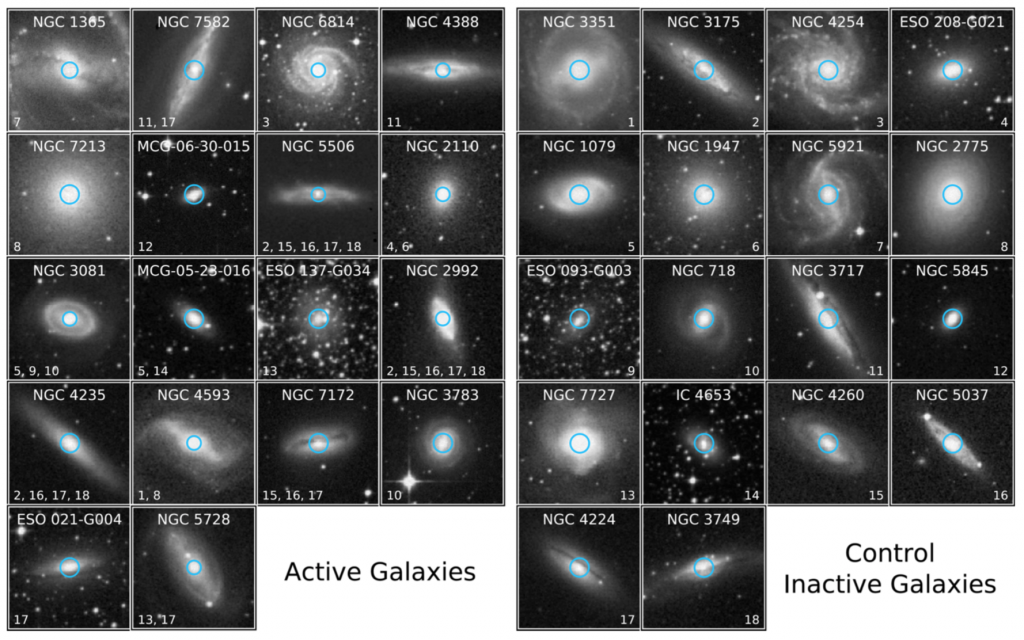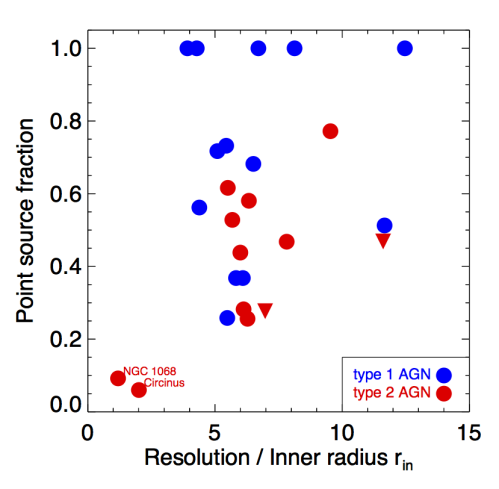LLAMA: Stellar populations in the nuclei of ultra-hard X-ray-selected AGN and matched inactive galaxies (A&A, 654, A132, 2021)
See my Twitter summary here (please see the tweet on Twitter to view the entire thread of 17 tweets):
Paper day! "#LLAMA: Stellar populations in the nuclei of ultra hard X-ray selected #AGN and matched inactive galaxies" (https://t.co/tQxf3lQXSX). Thread. 1/
— Leo Burtscher (@LeoBurtscher) May 17, 2021
The Subarcsecond Mid-Infrared View of Local Active Galactic Nuclei. IV. The L- and M-band Imaging Atlas (ApJ, 910, 2, 104, 2021)
Should you be looking for a high-resolution photometric measurement of a nearby (z < 0.3) active galaxy in the mid-infrared L or M bands (~ 3-5 micron), this atlas is your best chance of finding it! With 119 local AGNs it is the largest compilation of sub-arcsecond resolution images and photometric measurements to date. Apart from presenting carefully calibrated and extracted photometries, crucial for source selection for interferometric observations, we also analyse these galaxies’ photometries on nuclear color-magnitude diagrams and find that their colors match better to dusty torus models that include a wind component. Some sources are “bluer” than any model predicts and we find that this must be due to stellar contamination, even on these very nuclear scales.

Ph.D. project Turgay Caglar: LLAMA: The M_BH – sigma relation of the most luminous local AGNs (A&A 634, A114, 2020)
In this paper led by Ph.D. student Turgay Caglar, we estimated black hole masses and accretion rates for 10 broad-line LLAMA AGNs by using single-epoch reverberation mapping calibrations. In addition, we collected black hole masses from megamaser observations for two type 2 AGNs and estimated black hole masses for all other type 2 AGNs by using the M-sigma relation as derived from the 10 broad-line AGNs and the two type 2 AGNs with maser observations. We further looked into the reliability of the observables that make up the M-sigma relation and find very consistent stellar velocity dispersions as measured from the optical calcium triplet vs. the near-IR CO absorption bands. We further show that the dispersion as measured within a certain slit width can be corrected for a rotation component using our own SINFONI IFU observations of the LLAMA sample. We find tentative evidence that the so corrected dispersion measures put our AGNs closer to the inactive M-sigma relation.
Thick turbulent gas disks with magnetocentrifugal winds in active galactic nuclei: Model infrared emission and optical polarization (A&A 615, A164, 2018)
This is an article led by theorist Bernd Vollmer (Strasbourg, France) in which we try to find an analytical model that explains many observables of AGN tori: from IR colors to interferometric sizes to polarisation measurements. It was triggered by the discovery of compact polar-elongated dusty structures (e.g. see below) and explains them as originating from the transition region between the nuclear thick disks (as seen e.g. by SINFONI observations of hot H_2) and the compact nuclear disks seen by VLT interferometry as well as in water maser disks.
LLAMA: normal star formation efficiencies of molecular gas in the centres of luminous Seyfert galaxies (MNRAS 473, 5658, 2018)
Within the LLAMA project (20 AGNs + 20 matched control galaxies, see image above), we are searching for differences in the nuclei of X-ray selected AGNs compared to seemingly identical non-active galaxies. In this publication, led by David Rosario (Durham), we analysed APEX spectroscopy of the CO (2-1) sub-mm transition to estimate the amount of molecular gas in these galaxies. We find that the gas fractions and central SFEs of both active and inactive galaxies are similar when controlling for host stellar mass and morphology (Hubble type).
Mid-infrared interferometry of 23 AGN tori: On the significance of polar-elongated emission (A&A 591, A47, 2016)
The existence of compact polar-elongated dust in AGNs has uprooted the “unified model” of AGN tori in which the dust is oriented in a toroidal configuration in the plane of the nuclear engine rather than perpendicular to it. It had been unclear, however, how significant this polar emission component is in nearby AGNs. Is it a universal feature or just seen in a few weird objects? In this paper, led by former Ph.D. student Noel Lopez-Gonzaga, we looked at all 23 AGNs observed in the MIDI AGN Large Programme (Burtscher et al. 2013, see below) and tested first in which objects this component would have been detectable (based on the level of unresolved flux, the (u,v) coverage and the achieved signal/noise ratio). This resulted in seven objects. Five of these show clearly polar elongated emission (four of them were published before) and two are consistent with a round emission region. We conclude that nuclear polar elongated emission is indeed a common feature in AGNs.
On the relation of optical obscuration and X-ray absorption in Seyfert galaxies (A&A 586, A28, 2016)
In this follow-up work of our previous paper on the near-IR luminosity relations and dust colors, we relate the optical obscuration (derived essentially from the color temperature in the near-IR, employing our simple torus model) with the neutral gas absorbing column NH as measured from X-ray spectra. We find that both quantities are related in the sense that the measured X-ray column is as high or higher than the column corresponding to the optical obscuration and using a Galactic dust-to-gas ratio. This has of course been found previously in the literature (e.g. Maiolino et al. 1995, but also much earlier in Mushotzky 1982), but we present a very simple explanation for this, not inferring changing dust properties and such. Instead, we hypothesize that divergent optical and X-ray absorption simply arises because of neutral gas in the broad line region. We find evidence for this by looking at the variability of the X-ray column in our local AGNs. The central Figure of the paper is reproduced here and shows that many sources show significant variability in their X-ray column. The fiducial value using long-term averaged, BAT-derived columns from Claudio Ricci is indicated as squares, the variability range found in the literature is indicated with dashed lines. The variability is always in the expected direction based on our hypothesis. Those with columns higher than predicted from the Galactic ratio (blue band) show variability to lower columns and vice versa. We plan to follow up on this using dedicated X-ray observations.
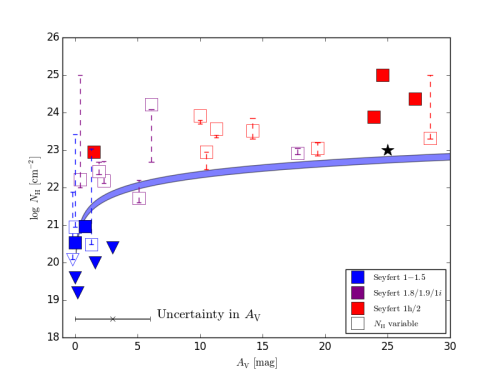
Obscuration in AGNs: near-infrared luminosity relations and dust colors (A&A 578, A47, 2015)
For this project, we collected a relatively large sample of local (D < 50 Mpc) Seyfert galaxies, all observed with integral field spectroscopy, in order to disentangle AGN and stellar emission in the near-infrared. We could show that Seyfert 1 galaxies follow a tight relation between near-IR AGN light and other AGN tracers, such as mid-IR emission or X-ray emission. Seyfert 2 galaxies are typically about 7 (10) times fainter in near-IR at a typical mid-IR (X-ray) luminosity of 10^42.5 erg/s.
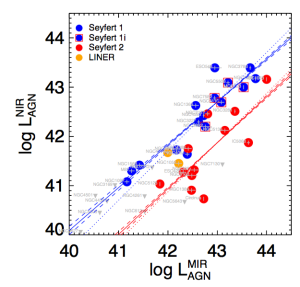
This can be easily explained in a simple “torus” model. This model consists only of two components: a hot component with an intrinsic temperature of about 1500 K and a warm component (300 K) that can obscure the hot component to produce redder near-to-mid infrared colors as well as cooler near-IR color temperatures. The model requires an area ratio of the warm and hot emitters which turns out to be in good agreement with observations: The radii to the warm and the hot dust are measured with infrared interferometry and the square of that ratio (~ 1000) is remarkably close to the area factor required in our simple model.
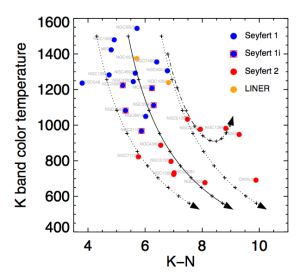
A diversity of dusty AGN tori — Data release for the VLTI/MIDI AGN Large Programme and first results for 23 galaxies (A&A, 558, A149, 2013)
This is the main publication from my Ph.D. thesis at the Max-Planck-Institute for Astronomy in Heidelberg and builds on the technical development of an observational strategy and data analysis method for applying mid-infrared interferometry to a much larger sample of AGNs than previously achieved (see the Interferometry & Instrumentation page for more details on this).
In this project, observationally organized as a VLTI Large Programme, we gathered interferometric data in the mid-infrared for a sample of 23 AGNs. We targeted essentially every source that was suspected to be bright enough in the hope to resolve its torus, i.e. the circumnuclear, AGN-heated dust structure. This was a large study, built on nearly 16 nights of (pairs of!) VLT/UT telescopes or a total of about 7 million science frames. The research paper has 46 pages (93 pages in the arXiv version). A summary is available in the ESO Messenger, its implications are discussed in the recent review by Hagai Netzer (chapter 3) and I describe the main result here below.
The data we gathered are essentially visibility amplitudes for a range of relative telescope positions in order to sample the (u,v) plane. The observations were performed in the thermal infrared (the atmospheric N band window between ca. 8 and 13 micron) because there the AGN heated dust is brightest and largest, i.e. easiest resolved (or so we thought). Since there are no bright spectral features connected with the AGN torus in the mid-infrared, we were mostly interested in the spatial structure, i.e. the sizes and possible sub-structures. Here is the summary plot for one of our sources showing that the source is mostly resolved with a structure of about 27 milli-arcsecond (or about 5 parsec) in size contributing most of the emission.

We analyzed the data for all 23 objects in this fashion to derive their sizes and some information on their structure or essentially just the level to which each object remains unresolved. We called this quantity the “point source fraction”. It turned out that many objects had very high point source fractions, i.e. were less well resolved than expected by us (based on the few previously available observations). This by itself was a major result and implies that further detailed studies require even higher angular resolution than achievable with the longest VLTI/UT baseline of 130m. Another important result evident from these plots is that essentially all objects seem to consist of two distinct components: a very compact “point source” and an extended source.
The point source fraction is also a simple enough quantity to be studied statistically and perhaps the main result, the diversity of dusty AGN tori (as highlighted in the title) is most straightforwardly shown this way.
In the figure above, the point source fraction is plotted against the normalized resolution we achieved with the interferometer. This requires a short explanation: Since the innermost radius of dust scales with the square root of the AGN luminosity, more luminous AGNs also have larger tori. And since the observed flux depends on distance squared, this relation also holds in observed quantities, i.e. brighter AGNs (in some flux unit, e.g. Jy) appear larger (subtend larger angles). This being said, if we normalize our instrument’s resolution to the inner radius of dust, we should get a quantity that allows us to estimate how well this particular torus is resolved. This quantity is plotted on the x-axis in the figure above. As you can see, there are two local AGNs which are very well resolved — we nearly resolve their dust sublimation radius in the mid-infrared. In most of the others our resolution element is about 5-8x larger than the inner radius. So, while we don’t resolve the smallest scales in these tori, we still obtain a relatively homogeneous resolution across our sample. Nevertheless, these tori appear very differently to us: some are almost entirely resolved, others unresolved. There is some trend with optical type in the sense that optical broad-line AGNs tend to be less well resolved than AGNs without optical broad lines, but both types populate almost the entire space between resolved and unresolved.
Another way of showing essentially the same is this “size-luminosity plot”:
Here, we show the half-light radii for all our 23 sources as a function of bolometric luminosity of the AGN. For reference we show the relations observed in the near-infrared from interferometry and continuum reverberation mapping (the green and yellow dots and lines). These observations show a relatively good and narrow correlation between radius and intrinsic luminosity. The explanation for this is of course that the size scale probed with these observations is special: It is the innermost radius where dust can exist. If it were closer to the AGN it would sublimate and no longer emit thermal radiation. The sizes derived from our mid-infrared observations, on the other hand, are not as tightly correlated with luminosity and show a diversity of dusty structures even at the same intrinsic luminosity.
The entire dataset has been published with CDS/Vizier and is available online for further investigations. Apart from the monochromatic visibilities which we analyzed using point-symmetric models, an investigation of the asymmetry of the emission is on-going (paper by Noel Lopez-Gonzaga is submitted) and a future project should use the full spectral bandwidth of the dataset to explore temperature gradients and covering factors.
In retrospect, this has been a very exciting and challenging project, both technically and scientifically. We opened up a new parameter space that was essentially unexplored until about 2004. With a resolution about 30x better than available before, we were discovering entirely new things, but also had little guidance as to what to expect and what to compare our findings to. There is simply no other instrument (at similar wavelengths) with a similarly sharp resolution. On the downside, I would like to note that we had much higher hopes when we put together the project in 2009, especially with regard to the structures we would find. We had hoped to find substructures indicative perhaps of individual clumps or at least filaments of dust (as seen in hydrodynamical simulations of the nuclei of galaxies). This we did not find. The reason for this was partly that hadn’t yet developed fully our analysis methods for the faintest objects (in order to understand the sensitivities and precisions required to find the desired substructures). But to a large part it was also due to the fact that these objects just happened to be less resolved than expected. C’est la vie.
Older publications:
- My Ph.D. thesis “Mid-infrared interferometry of AGN cores” (supervisor: Klaus Meisenheimer, MPIA) published by the University of Heidelberg (in case you wonder about the apparent pleonasm “AGN core”: while AGN of course stands for Active Galactic Nucleus, it is more frequently used in the meaning “A galaxy harboring an AGN”. To make clear that my research targeted the very centers of these objects, namely the central parsec, I decided to use “AGN core” in the title of my dissertation.)
- Resolving the Nucleus of Centaurus A at Mid-Infrared Wavelengths (PASA, 27, 490, 2010)
- Dust emission from a parsec-scale structure in the Seyfert 1 nucleus of NGC 4151 (ApJ, 705, L53, 2009)
- My diploma thesis “Two zone SSC model for blazar jets” (supervisor: Karl Mannheim, University of Würzburg) is unfortunately unpublished. However, I spent quite some effort at the time to extensively document the elegant theoretical framework of the Kirk, Rieger, Mastichiadis (1995) model I was working with. This is a two-zone Synchrotron Self-Compton (SSC) model invoked to explain the spectral hysteresis (in spectral hardness — intensity space) seen in Galactic X-ray binary sources. In my diploma thesis, I expanded the model with an Inverse Compton component. This allowed to explain, qualitatively at least, a similar behaviour seen in blazars, i.e. powerful, jet-dominated Active Galactic Nuclei. I sincerely recommend reading my thesis if you are interested in blazar models or the theory of radiation processes in astrophysics.
My ORCID: 0000-0003-1014-043X
A list of all scientific publications I have been involved in on ADS
